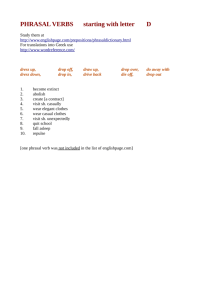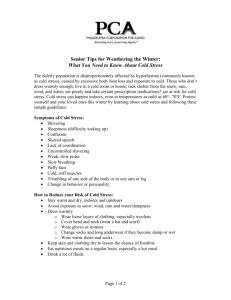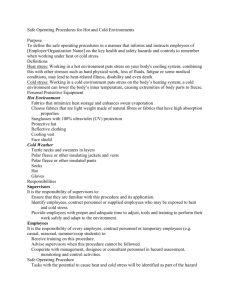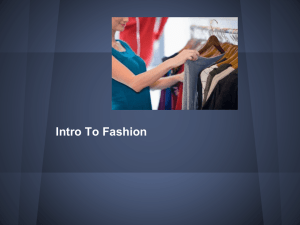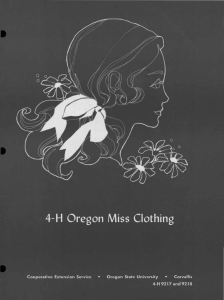Clothing Needs
advertisement
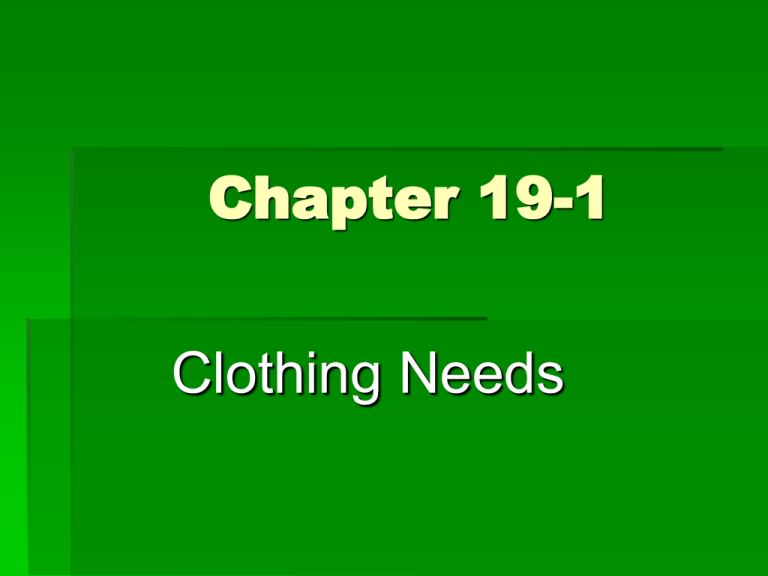
Chapter 19-1 Clothing Needs Factors that influence clothing decisions Physical Needs Protection Psychological Needs Adornment Social Needs Identification Modesty Status Physical Needs Protection Weather Cold temperatures Sunshine High winds Rain Protection Environmental Dangers Provide physical protection from dirt, insects, and harmful agents Shoes for rough terrain Jackets with hoods to keep insects away Life jackets when near/on a body of water Space suits Protection Workplace Hazards Guard against bruises, cuts, burns, etc. Hard hats Safety goggles Gloves Reflective clothing (vests) Sterile gloves, face masks, for medical professionals Specialized garments to protect against contamination, chemicals, radiation and fires Athletes wear helmets, gloves, pads, and shoes Protection Against Enemies body shields and suits of armor in past Military Helmets Pockets & belts to hold weapons Camouflage fabric Police officers –bullet proof vests Some cultures believe clothing can protect against evil spirits, illness, etc good luck charms Medallions Many of your physical needs for clothing are determined by your lifestyle Lifestyle – a person’s way of life or style of living Daily activities dictate most clothing choices Psychological Needs Adornment - decoration Provides psychological feeling of well being through beauty Wearing clothes that enhance your appearance can boost your self-esteem Certain colors, fabrics, and styles of clothing can affect how you feel Adornment is found in various cultures through history Paint Jewelry Body scarring Hair styles Fabrics differ by culture Through adornment we can express creativity and individuality Clothing contributes to feeling of self-respect, self acceptance and self esteem Social Needs Group Identification Group identity shown by dressing like those with whom you associate Satisfies need to belong Profession Social group Country of heritage Group Identification Uniforms are one way to indicate belonging to a group Outfits or articles of clothing identify those who wear them with a group Athletes Military personnel Students Unwritten rules of dress-people of same age, etc. dress alike Some groups use certain colors or symbols to identify their members Sororities & fraternities (Greek letters) Group Identification Dress codes – standards of dress that are enforced in a social setting Formal dress codes are based on the belief that how people dress tends to affect their behavior work school Informal dress codes exist in society and reflect popular beliefs about modesty Modesty The covering of a person’s body according to the code of decency of that person’s society Dictates the proper way to cover the body for social acceptance Molded by our culture and social system Standards of our society about modesty have changed Status A person’s position or rank in comparison to others High status associated with recognition, prestige and social acceptance Clothing used to gain a higher rank in society People willing to pay extra for garments with most desired labels and logos Shows others what they’ve achieved Military uniform – stripes Scouts – badges Athletic letter Choosing Clothes for Specific Occasions Different types of clothes are needed for different occasions Formal attire for a wedding or a prom Career attire for a job interview Choosing the right clothes for the occasion can greatly influence your personal effectiveness If you are uncertain about what to wear for an occasion, check with others Did You Know? Your attire for a job interview depends on the type of job. Wear clothes a step more formal than employees wear every day. Make sure your clothes are clean and neat. © Stephen Coburn/Shutterstock Special Needs Some people, such as older adults or people with disabilities, may need clothes that are comfortable easy care easy to get on and off easy to move in © Dmitriy Shironosov/Shutterstock Elastic waist, knit fabrics, simple fasteners, larger openings Warm-up September 10, 2014 Create a T chart indicating the pros and cons of school uniforms. Warm-up September 9, 2014 What are three types of needs met by clothing?
